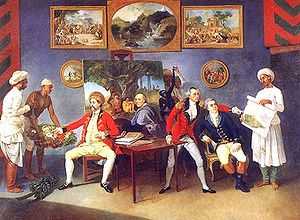Antoine Polier
| Colonel Antoine-Louis Henri de Polier | |
|---|---|
| Born |
1741 Lausanne |
| Died |
7 February 1795 France |
| Occupation | Engineer |
| Spouse(s) | three |
| Children | three |
Colonel Antoine-Louis Henri de Polier (1741–1795) was a Swiss adventurer, art collector, military engineer and soldier who made his fortune in India in the eighteenth century.
Early life

Antoine-Louis was born in Lausanne[1] from a French Huguenot family who emigrated to Switzerland in the mid 16th century to escape the wars of religion. He was the youngest son of Jacques-Henri de Polier and his wife Jeanne-Françoise Moreau. He later learned Hindi and Persian.

Cite error: There are <ref> tags on this page, but the references will not show without a {{reflist}} template (see the help page).
Antoine Polier was an engineer from Lausanne who supported the military adventures of Robert Clive and later became a rich trader and loyal supporter of the British Raj administration in Calcutta. He devoted his free moments to collecting rare manuscripts in Sanskrit, Persian and Arabic. Many were sent back to France to augment the growing collection in the Royal Library. France was now the center for the study of ancient Indian languages and its 'orientalism' spread to Germany in the early 1800s as Europe began to show a keen interest in early Indian-Persian-Zoroastrian origins.[1]
In India, he had two Indian wives, Jugnu and Zinat,[2] one senior and one junior and three children. He acquired a large art collection and became rich working for the Indian royalty. In 1788 he left his Indian wives with his loyal companion and fellow enlightened adventurer,Claude Martin.[2] and settled in France with an unfortunate timing as he arrived in time for the French revolution. Having purchased a chateau and taking a French wife and two children, Charles de Polier and Adolphe de Polier. He was assassinated in Avignon on February 9, 1795 in the terror that followed the French revolution.[3]
Legacy
His collection of miniatures are in Berlin.
See also
References
- ↑ 1.0 1.1 Maya Jasanoff, 'Edge of Empire: Conquest and Collecting on the Eastern Frontiers of the British Empire, 1750-1850' Fourth Estate
- ↑ 2.0 2.1 A Man of the Enlightenment in 18th Century India: The Letters of Claude Martin, 1766-1800. Retrieved 2007-05-17.
- ↑ William Dalrymple 'Antoines Junior Bibi' Sept 27 2002 Timesonline accessed July 2007
Further reading
- A European Experience of the Mughal Orient: The I’jaz-i Arsalani (Persian Letters, 1773–1779) of Antoine-Louis-Henri Polier - Translated with an introduction by Muzaffar Alam and Seema Alavi. Pub.Oxford University Press ISBN 0-19-564980-X
Jean-Marie Lafont, Indika. Essays in Indo-French Relations 1630-1976. New Delhi 2000. [An extremely useful book outlining French activities in India during Polier's time] ISBN 81-7304 278 0
| Wikimedia Commons has media related to Antoine-Louis Polier. |
|